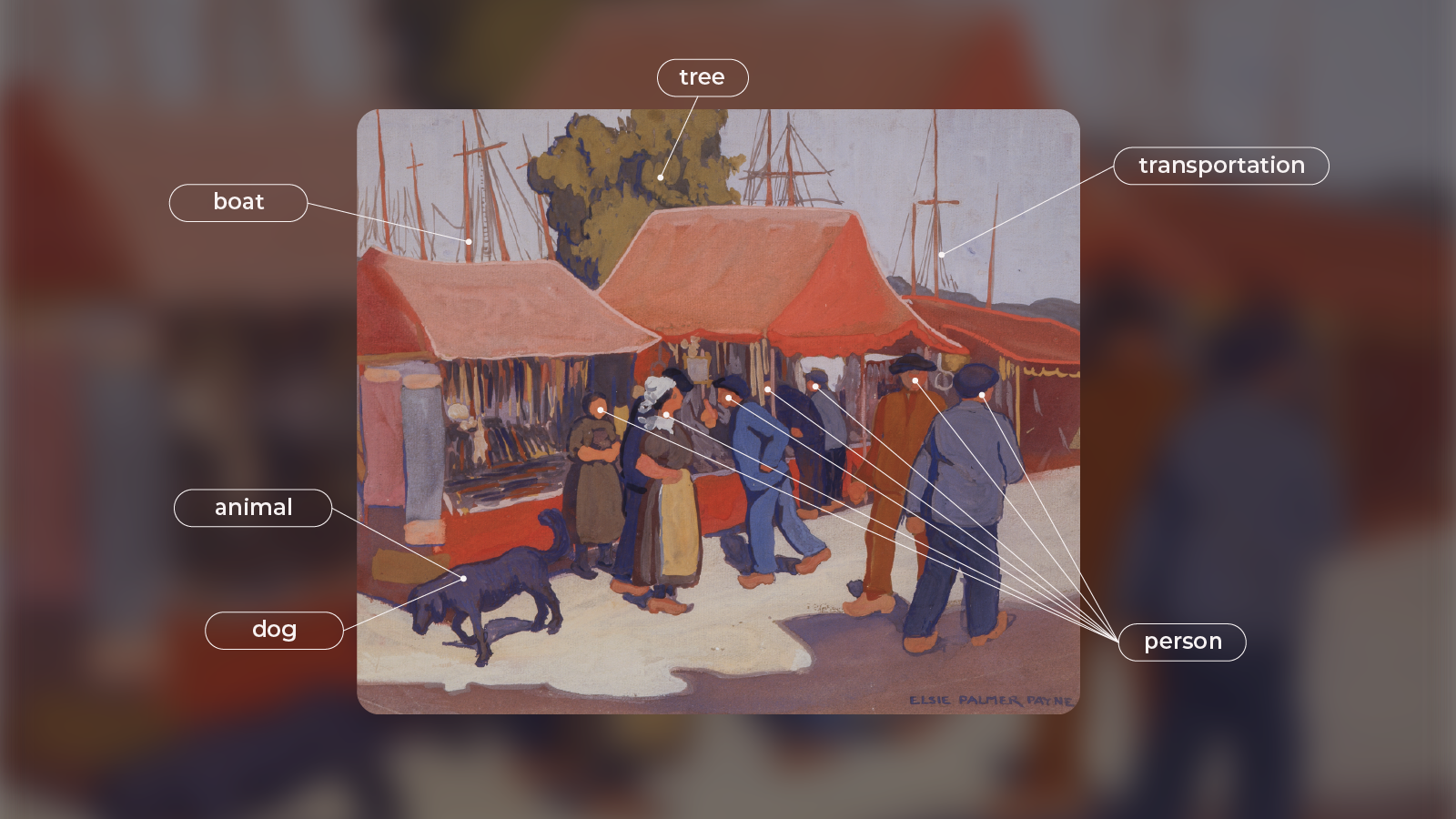AI Meets Art: How UCI's Langson IMCA is Revolutionizing Art Cataloging

Graphic includes Elsie Palmer Payne, Fishwives' Quarrel, Brittany, 1928, Gouache on paper, 11 1/2 x 14 in. The Buck Collection at UC Irvine Jack and Shanaz Langson Institute and Museum of California Art. Graphic edits by Theresa Phan/UCI.
May 22, 2025
By Kristen McIntyre
In the world of museum collection management, the task of cataloging and keyword assignment has long been a labor-intensive process. However, a new collaboration between the Jack and Shanaz Langson Institute and Museum of California Art (Langson IMCA), ZotGPT, and an Information and Computer Science (ICS) student is changing the game. This innovative partnership has opened up a new world of possibilities for AI-powered solutions in collection management.
Langson IMCA, UC Irvine's art museum, with a collection of over 4,700 California artworks, faced a significant challenge. Amy Lim, Senior Director, Collections and Exhibitions Management, explains, "It took two full-time staff members over six months just to inventory and catalogue about 1,300 artworks. Manually assigning multiple keywords to our entire collection would have taken years."
This time-consuming process involved unpacking, photographing, measuring, and documenting each object. Moreover, without comprehensive keywords, searching the database was limited, making it difficult for those unfamiliar with the collection to find specific types of artworks.
Enter Connor Tintorer, a UCI undergraduate studying Information & Computer Sciences (ICS). When the idea was thrown around to possibly utilize AI for assigning keywords, Tintorer jumped at the opportunity and ran with it. Utilizing ZotGPT API, part of UCI's homegrown AI platform, and under the guidance of Jehan Tillekeratne, Langson IMCA's Data Analyst, Tintorer single-handedly developed an AI-powered program that transformed the museum's cataloging process. The program was designed to analyze images of artworks and generate relevant keywords. They faced several challenges, including converting image files into a format acceptable by the ZotGPT API and managing server-based processing issues. Despite these hurdles, a robust system capable of processing thousands of images was ultimately created.

Fishwives' Quarrel, Brittany was analyzed using Tintorer's AI-powered program, generating relevant keywords. Notably, the program was able to tag the word “boat” despite the masts being in the background. Graphic edits by Theresa Phan/UCI.
The implementation of this innovative approach proved to be quite successful. In a single night, the AI program processed 3,356 images of Langson IMCA's collection, generating an average of 44 keywords per artwork. The AI's ability to identify subtle details in artworks that might be overlooked in a quick manual review has significantly enhanced the museum's ability to search and categorize its collection. Tillekeratne explained that they were surprised at some of the subtleties it picked up like “identifying small details a human might overlook in a rush. For example, the keyword 'boat' was correctly tagged on the work Fishwives' Quarrel, Brittany by Elsie Palmer Payne, even though only the masts of the boats are visible in the background.” He also emphasizes the accuracy and usefulness of the AI-generated keywords, stating that the AI was correct well over 90% of the time for the keywords they manually reviewed.
The impact of this AI-powered solution extends beyond mere efficiency. It has also improved the searchability and accessibility of the collection. Previously, searching for a term like 'woman' would only yield results where the word appeared in the artwork's title, missing many relevant pieces such as untitled sketches of women. With the AI-generated keywords, the search capabilities have been exponentially expanded, making the collection more accessible to researchers and curators.
Interestingly, the project has also revealed current limitations of AI technology. The system performs better with certain images and more basic keywords. Tintorer says, "Another thing we had to keep in mind was, what can the AI actually understand? Because some categories we noticed were too abstract or complex for the AI to produce accurate results. Like tonalism, for example, the AI didn't flag anything as tonalism because it was too complex a concept. We worked with our curators to ensure keywords were being applied appropriately and to understand how we could better train the AI to identify certain attributes." This insight helps the museum understand where AI can be most effectively applied and where human insight is irreplaceable.
Tintorer's work has also sparked a shift in perspective regarding the role of AI in collection management. Lim notes, "This project has opened our eyes to the potential of AI as a valuable tool in museum operations, particularly in collections management. It's not about replacing human expertise, but rather augmenting our capabilities to work more efficiently, especially with limited resources. But I'm thrilled with the results we've seen so far."
Looking to the future, Langson IMCA has ambitious plans to leverage this technology further. The museum is actively digitizing its collection and developing an online platform to make its artworks easily searchable, with the hope of eventually providing convenient access for the public as well as UC Irvine faculty and students for research purposes. The success of this collaboration between Langson IMCA, ZotGPT, and one of UCI's talented ICS students serves as a compelling example of the potential for interdisciplinary partnerships in solving complex challenges. It demonstrates how academic institutions can leverage their diverse resources and expertise to drive innovation and create practical solutions for real-world problems.
By embracing technology while continuing to value human expertise, institutions can enhance their ability to preserve, study, and share our cultural heritage more effectively than ever before.
Tom Andriola, UCI's Chief Digital Officer adds, "This project not only showcases the power of AI in art cataloging but also highlights the importance of collaboration between different disciplines in driving innovation. As we move forward, it's clear that the intersection of technology and art will continue to open new possibilities for museums and art institutions worldwide."